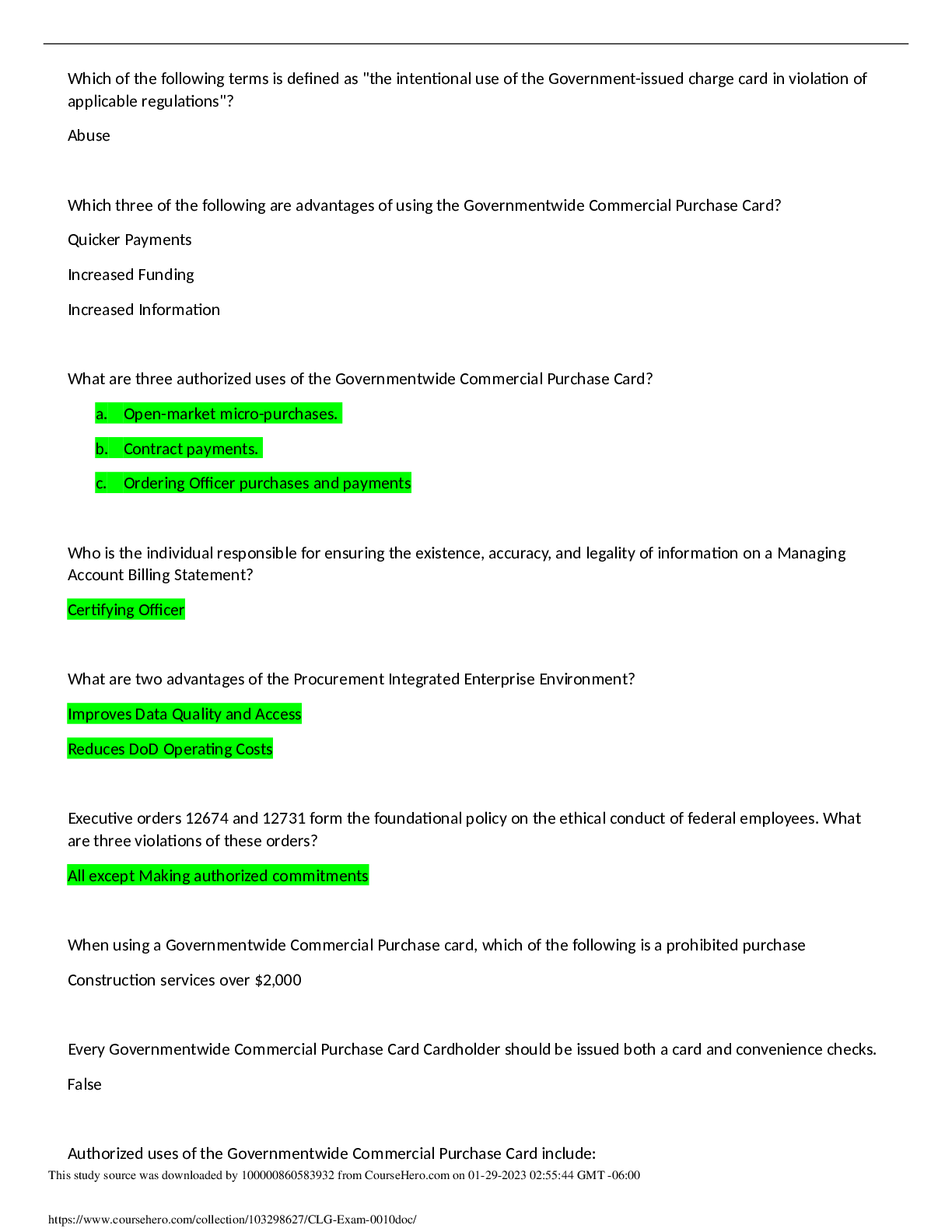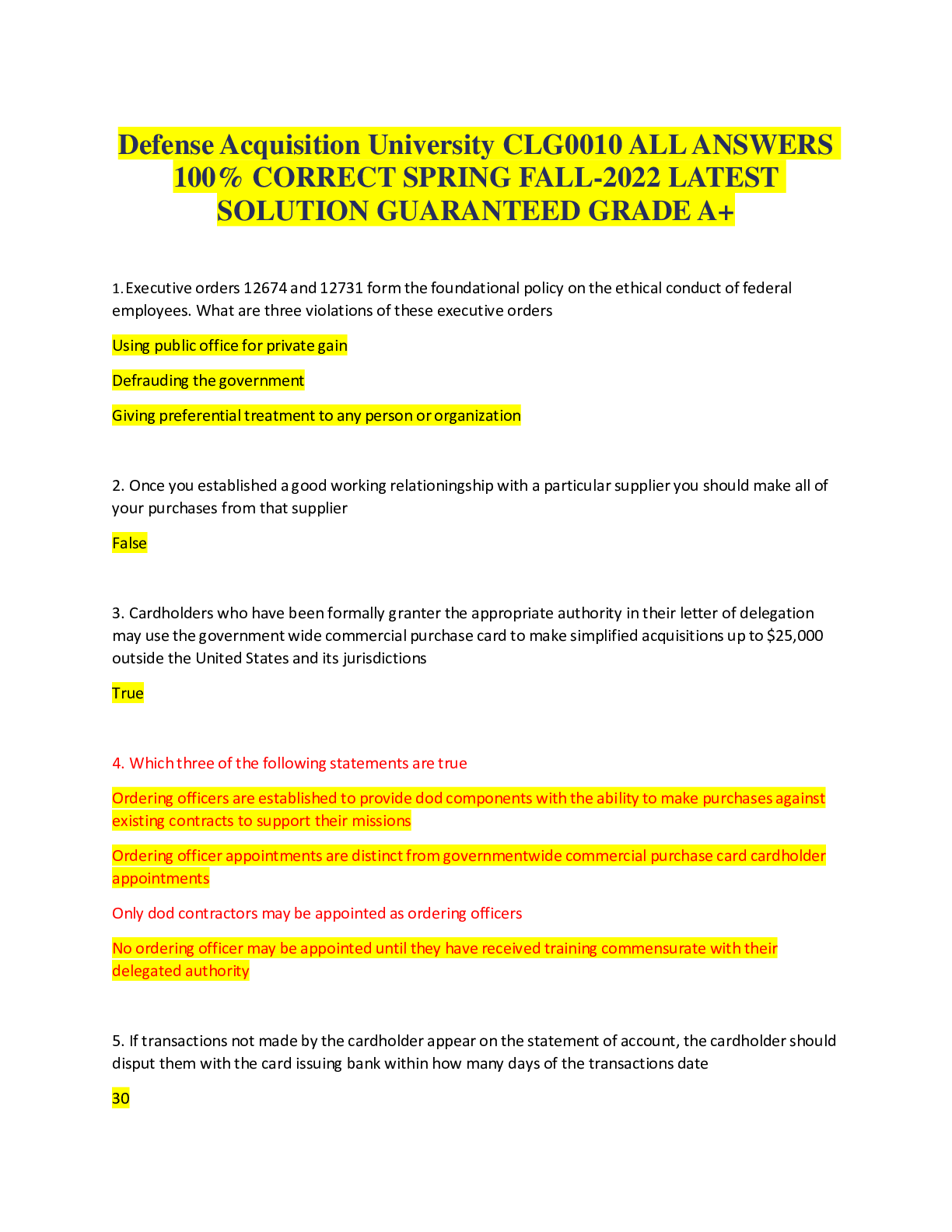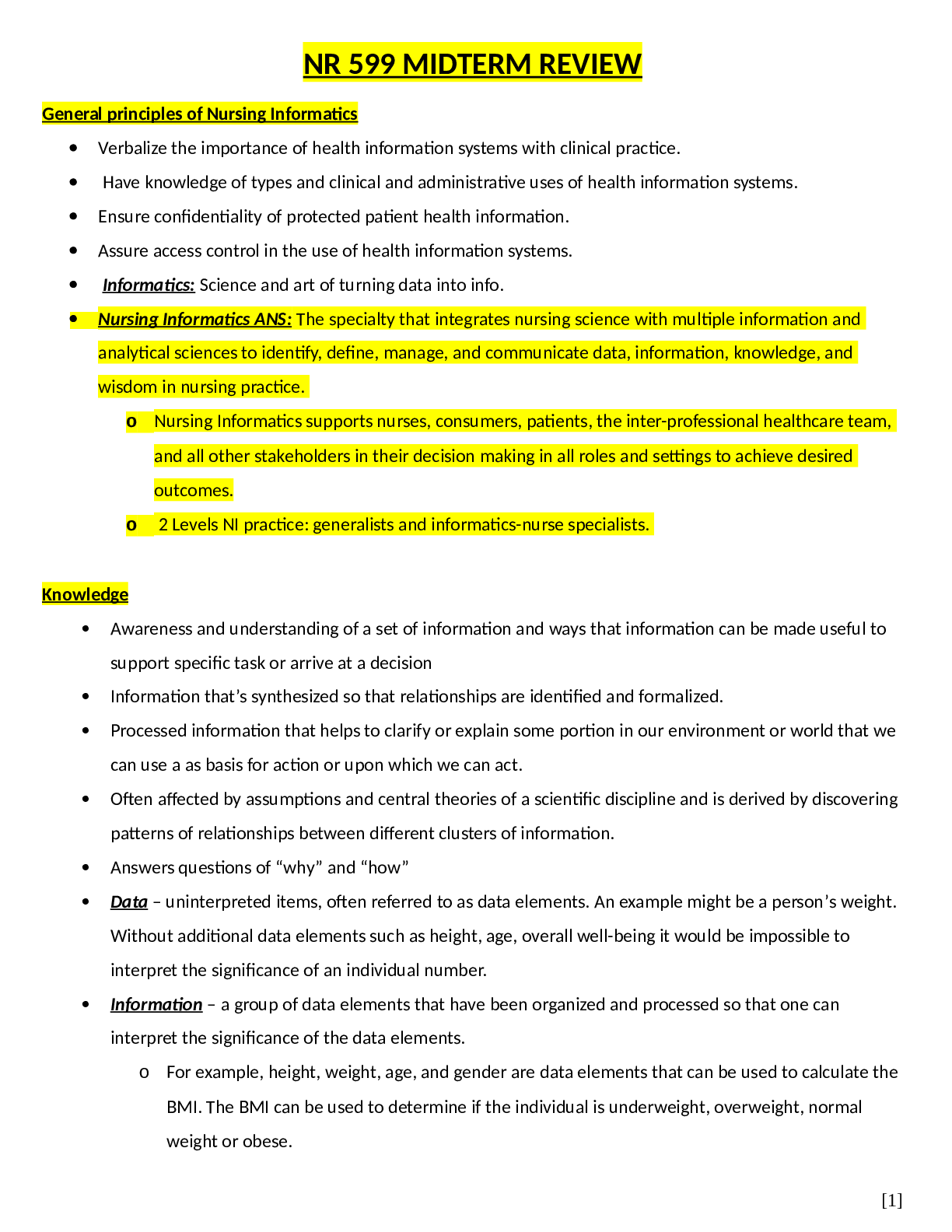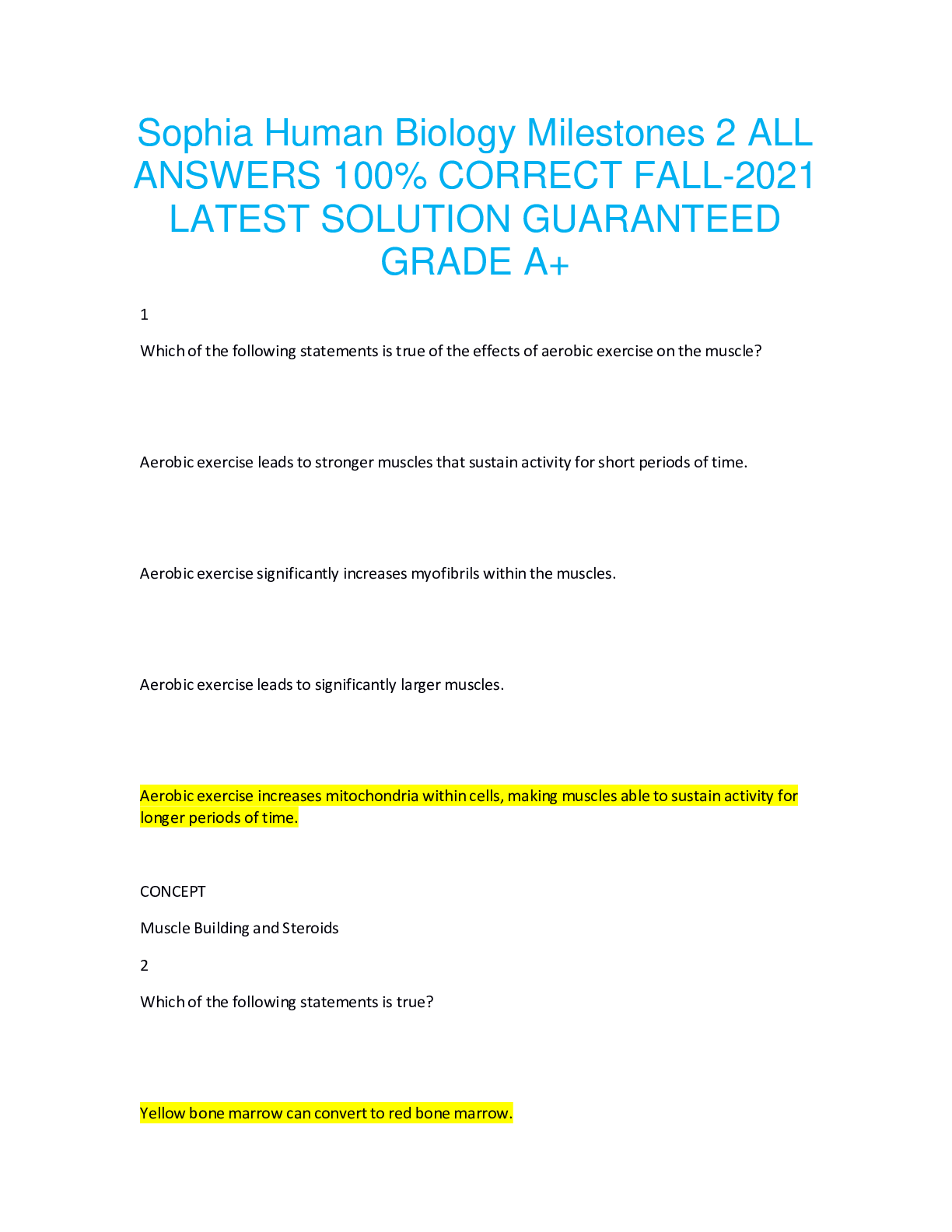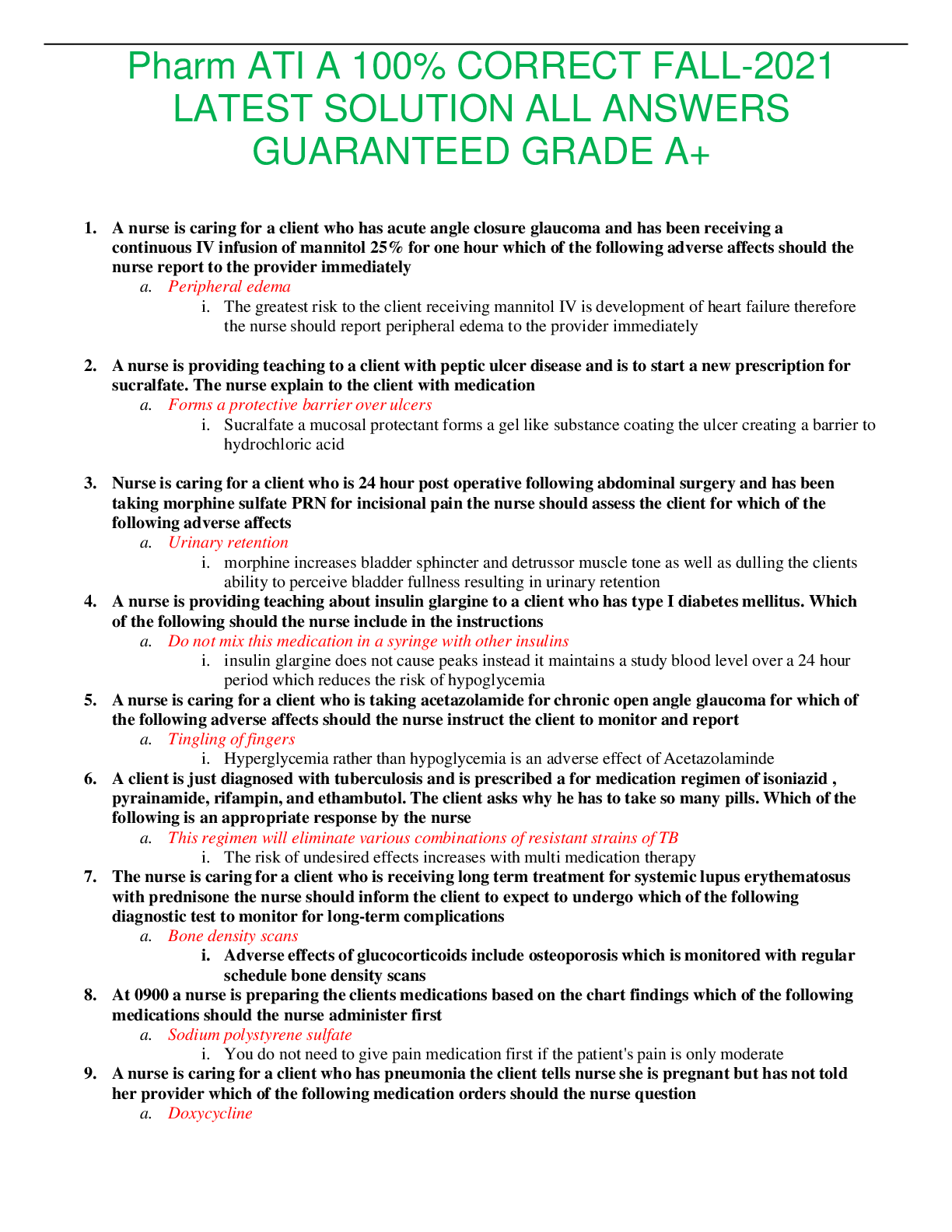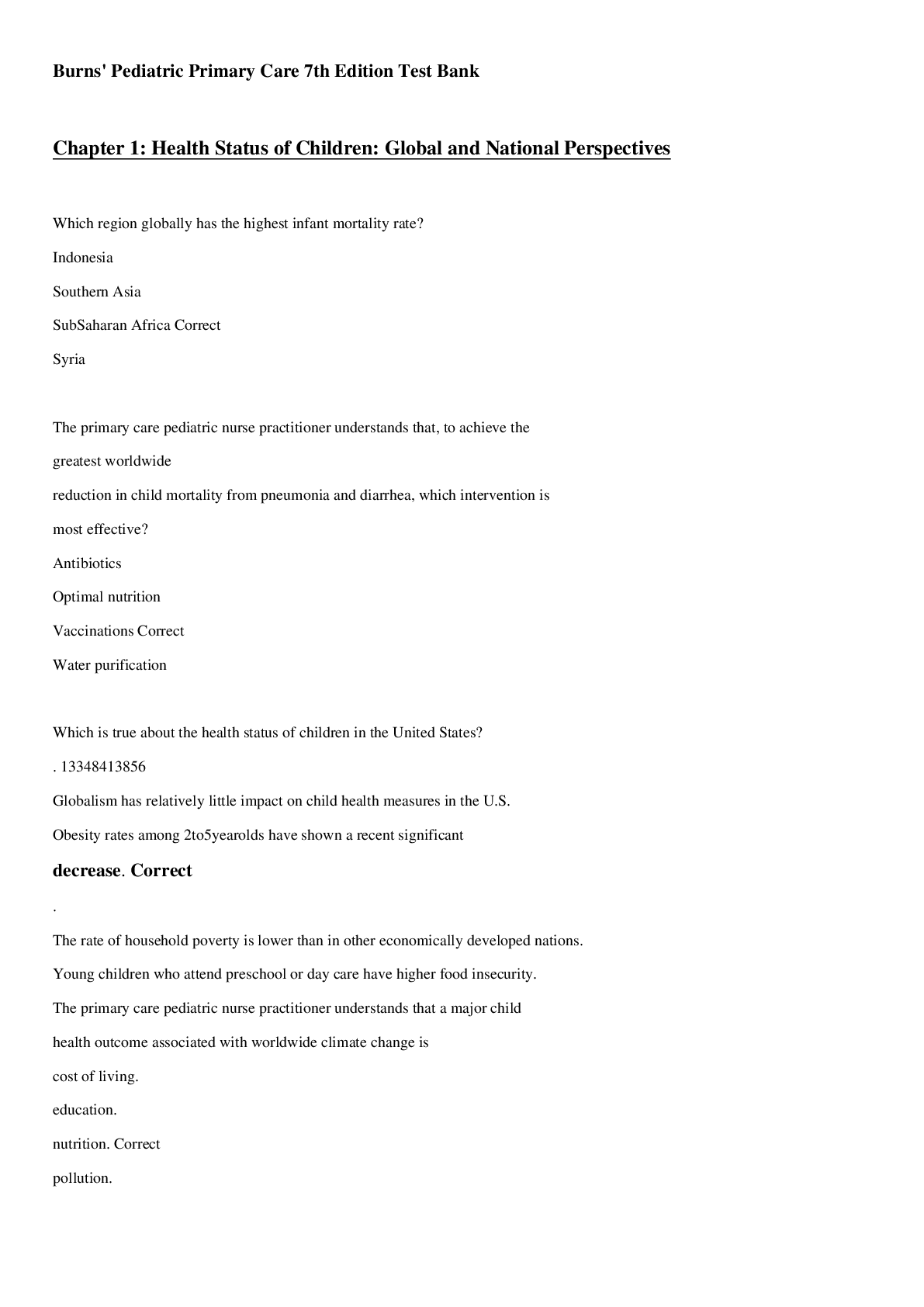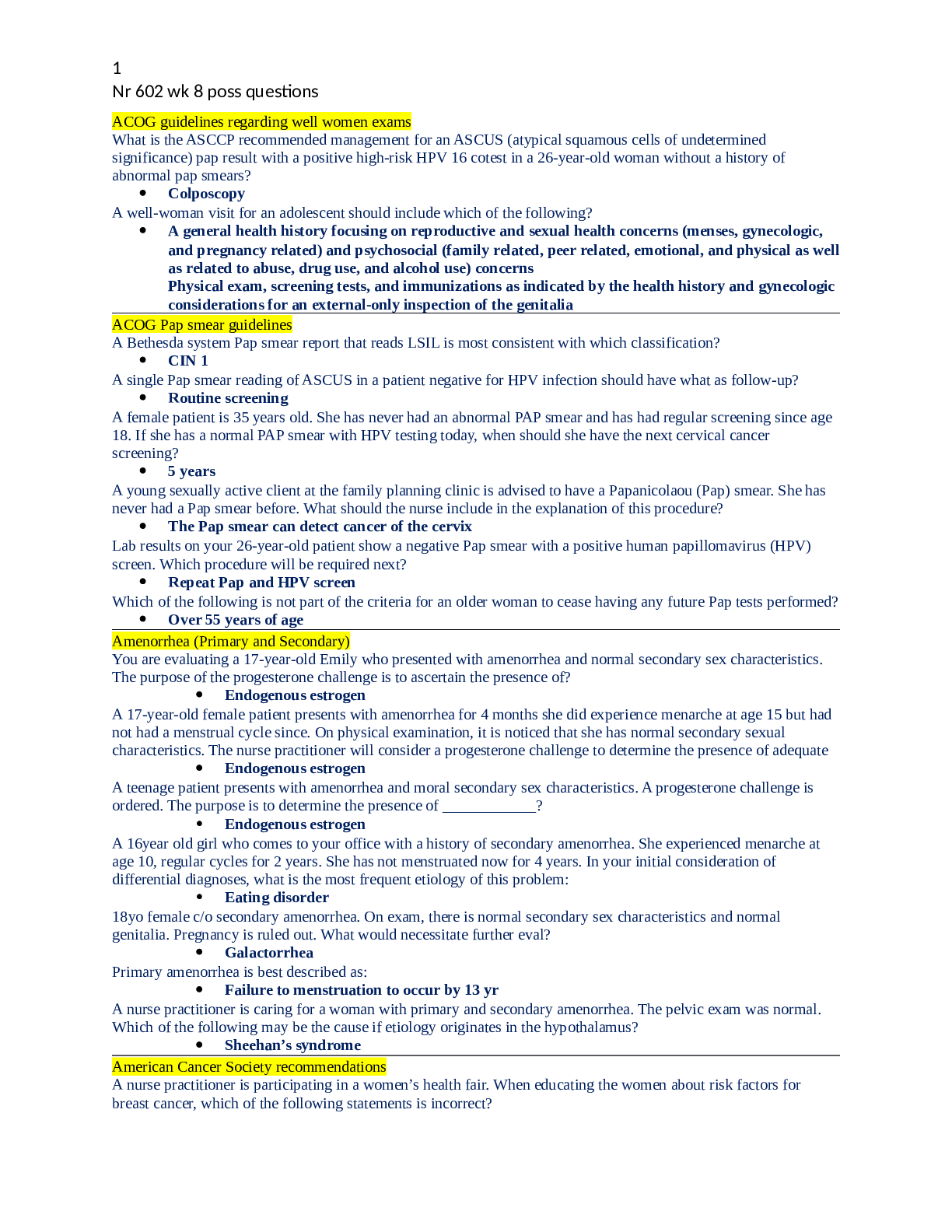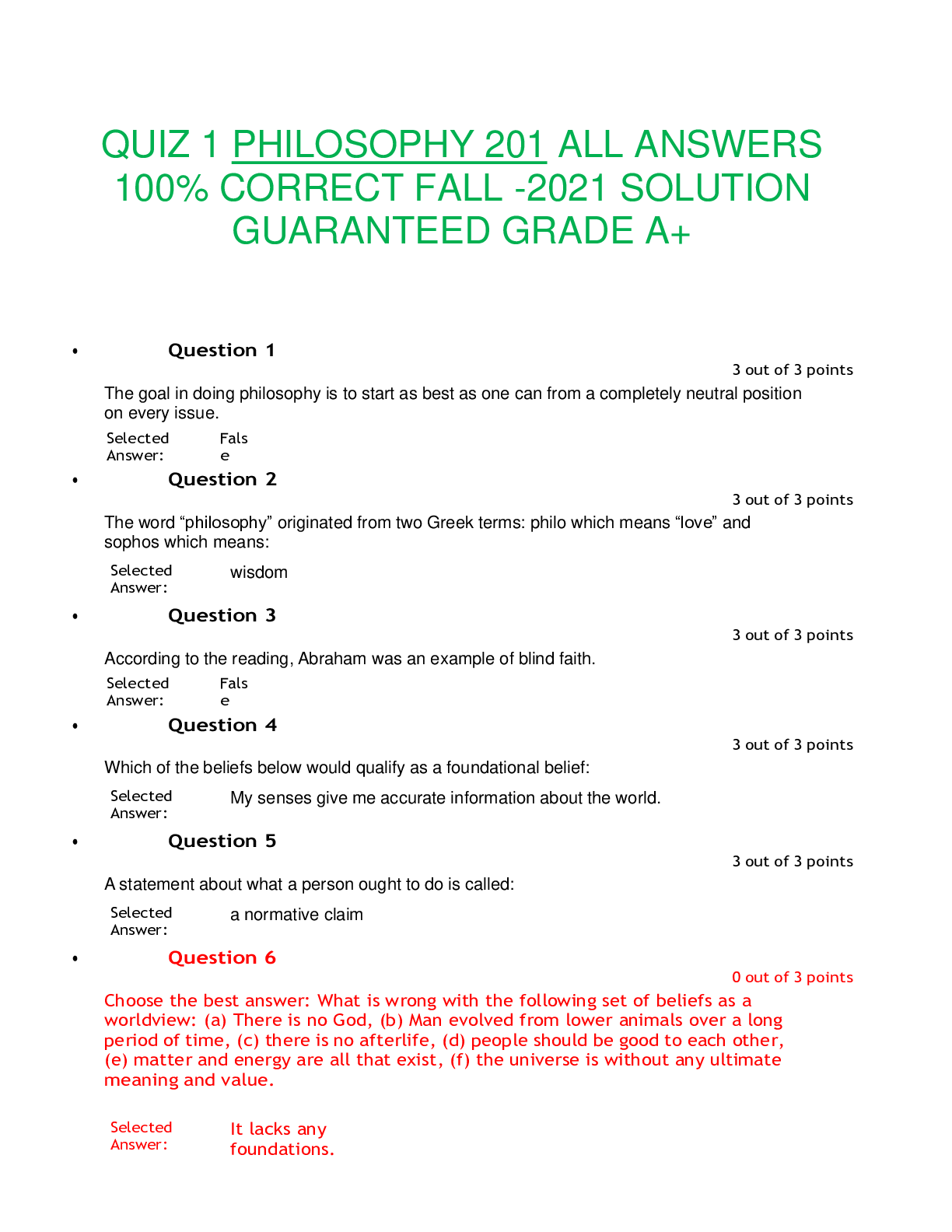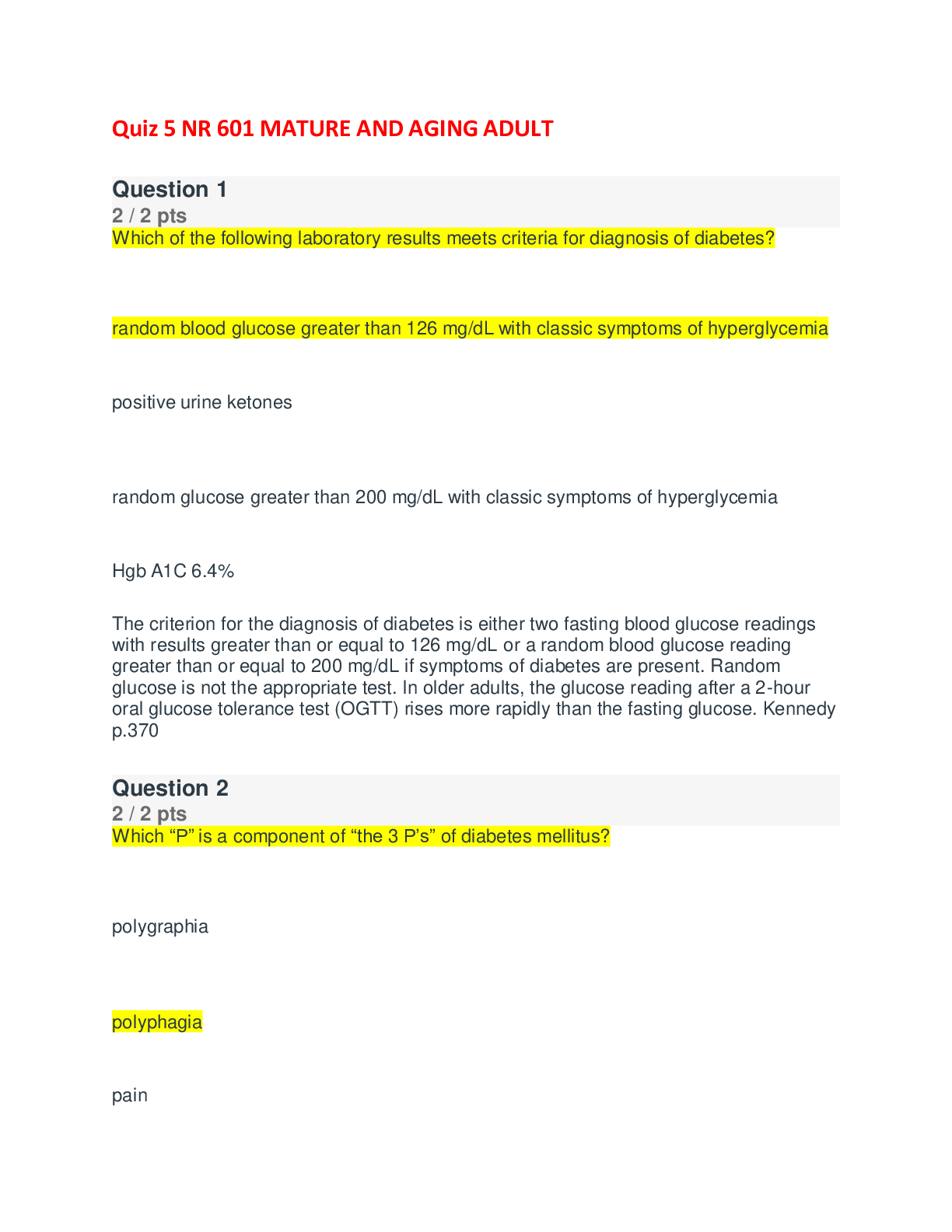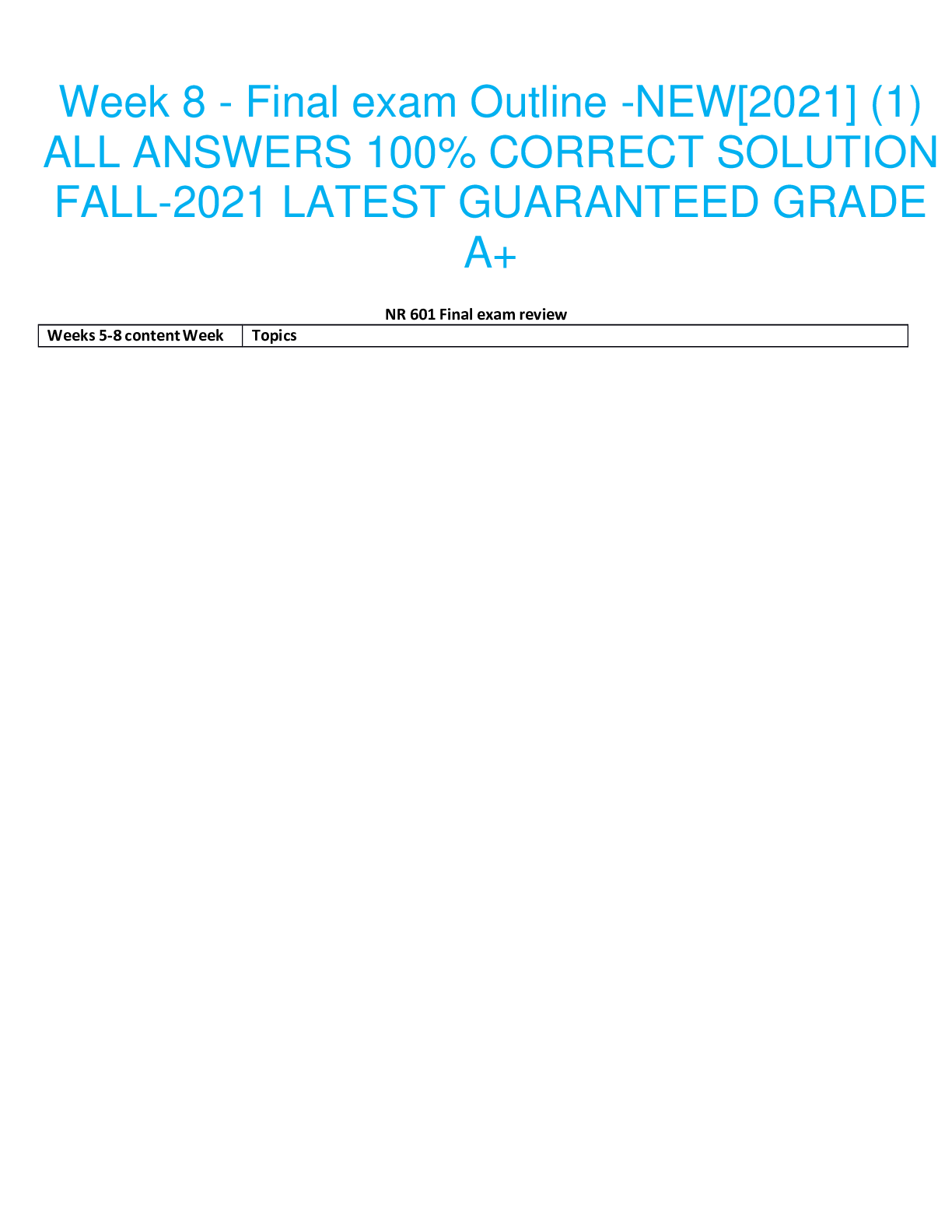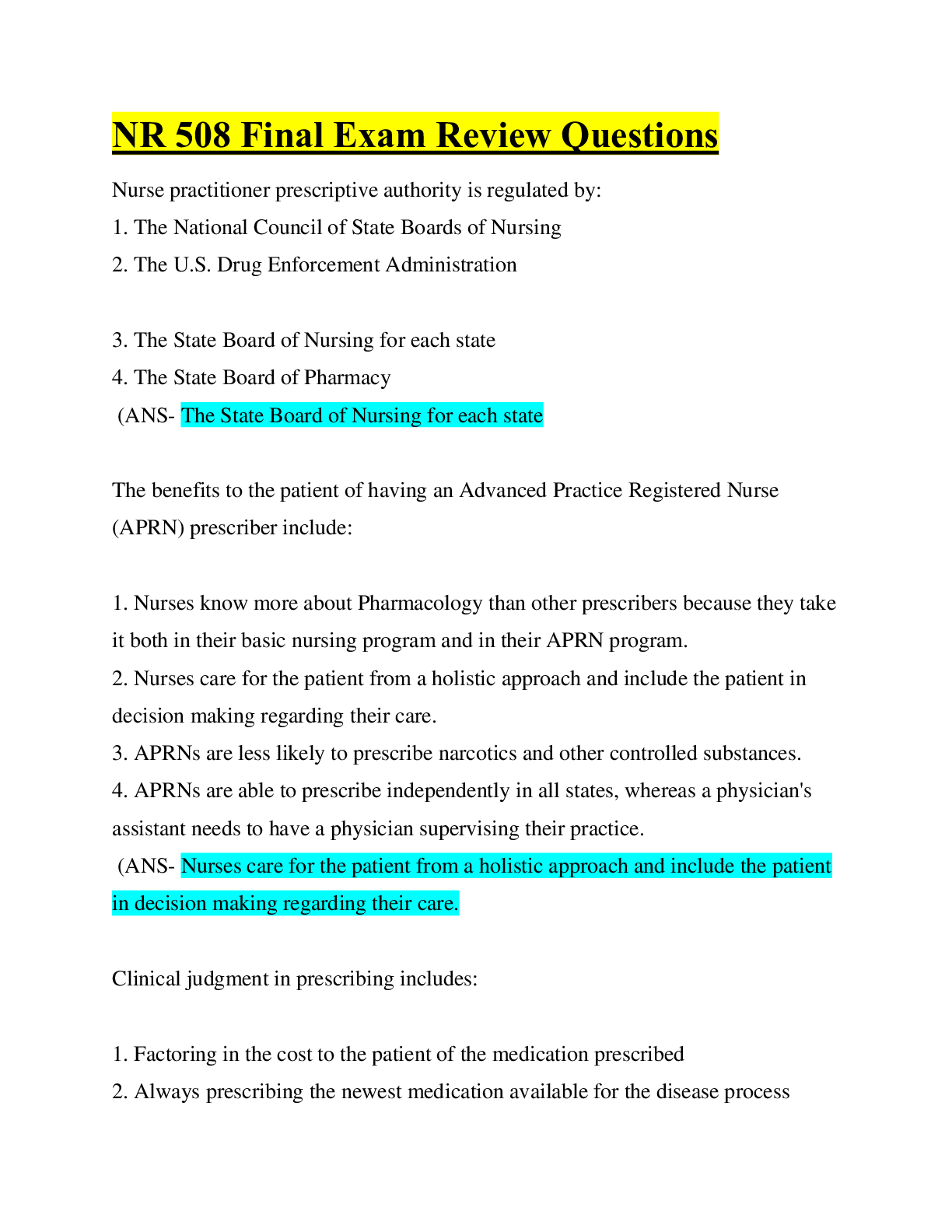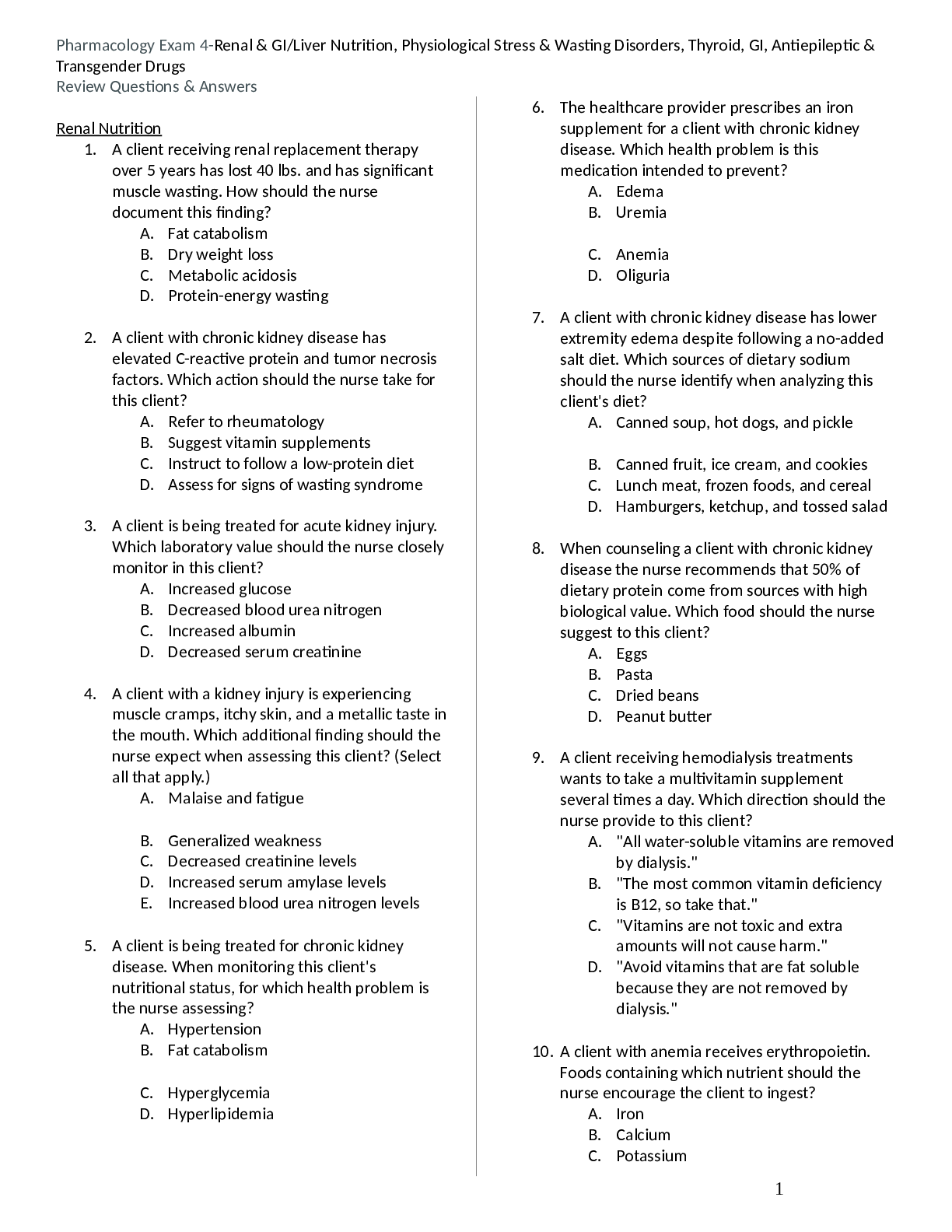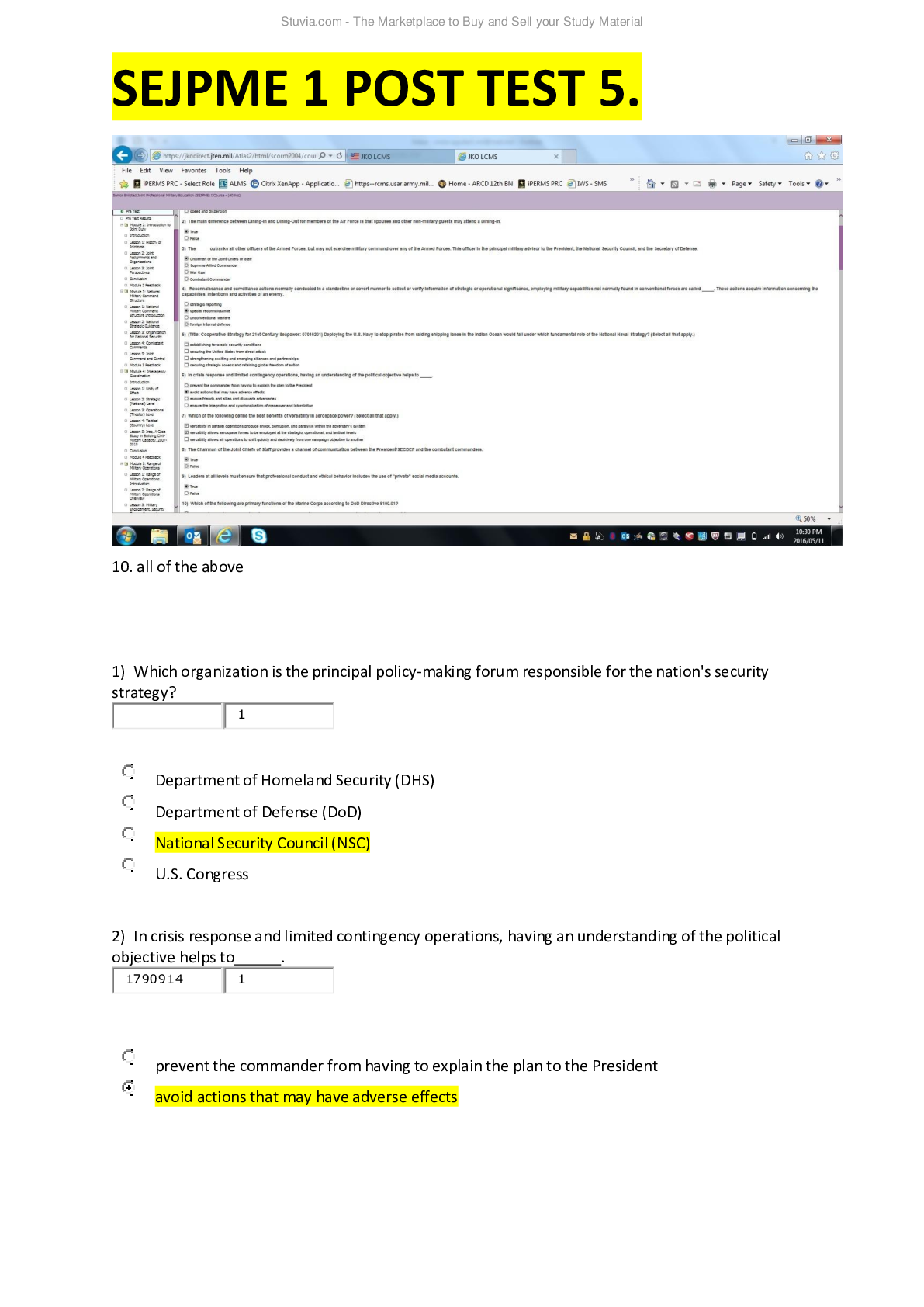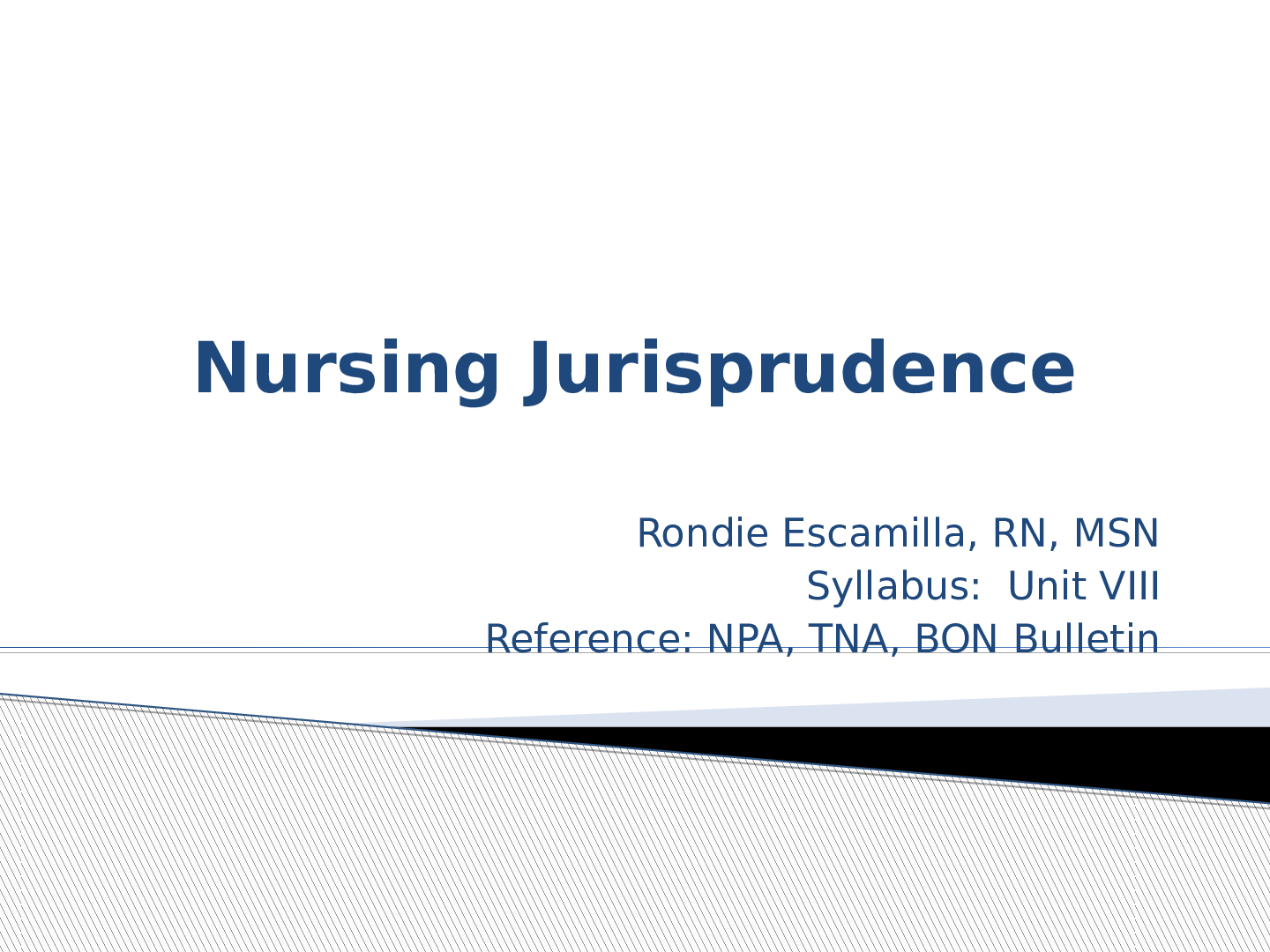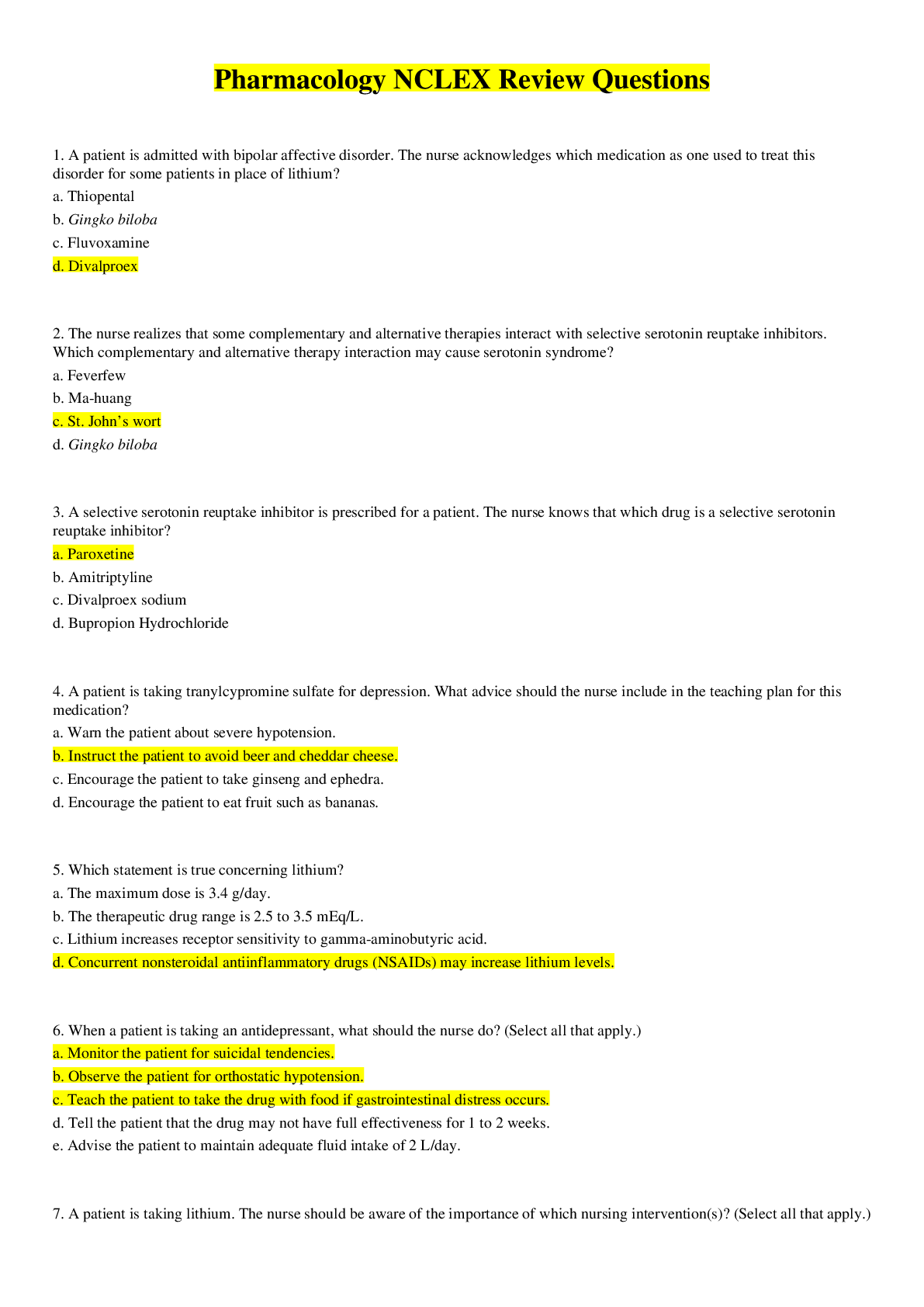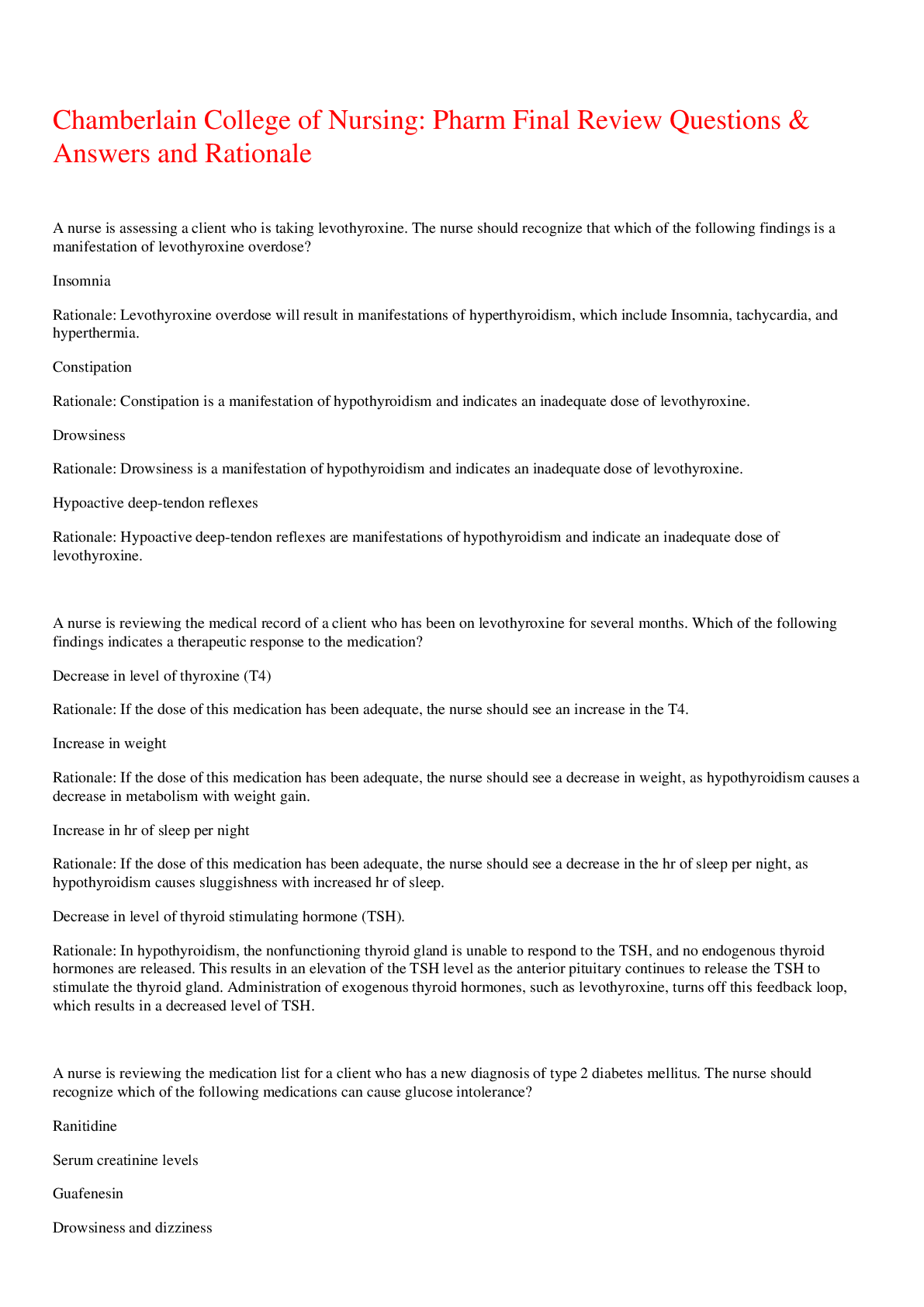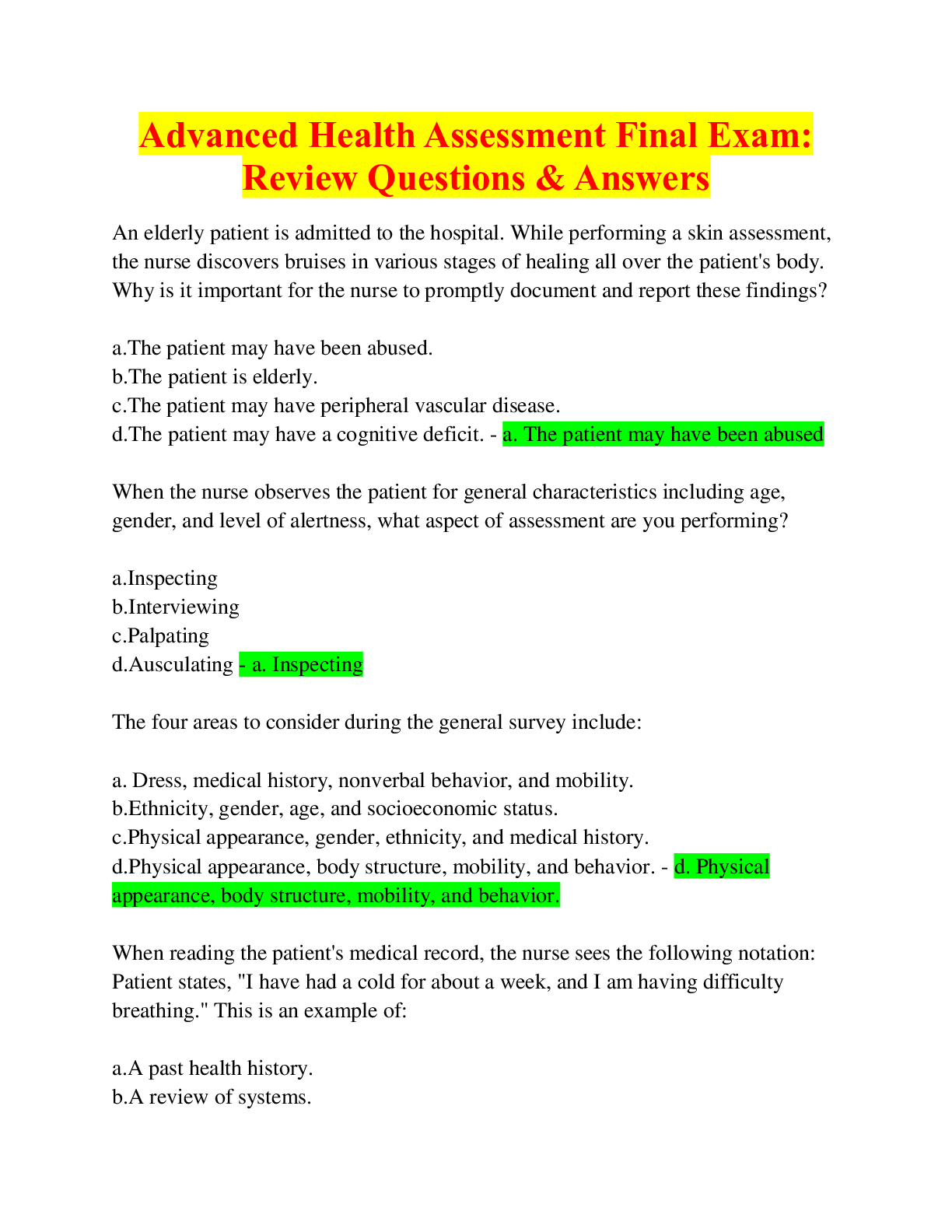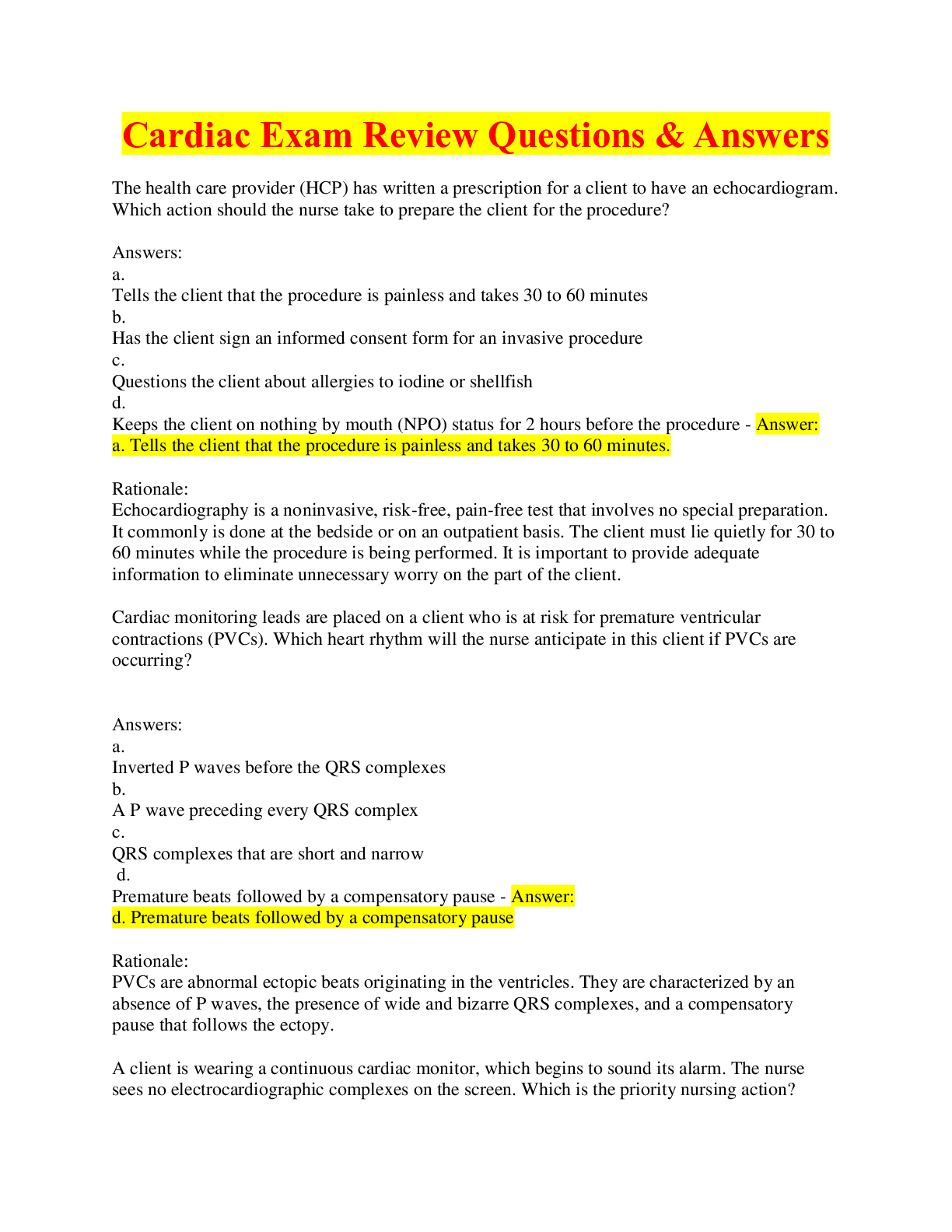Physiology > EXAM REVIEW > Psychology Exam Review Questions & ANSWERS ALL SOLUTION 2024 EDITION GUARANTEED GRADE A+ (All)
Psychology Exam Review Questions & ANSWERS ALL SOLUTION 2024 EDITION GUARANTEED GRADE A+
Document Content and Description Below
Chapter 1: Psychology: The Evolution of a Science ... What is psychology? What is the mind? What is behavior? Psychology is the scientific study of the mind and behavior Mind is our private inner ... experience of perceptions, thoughts, memories, and feelings Behavior is the observable actions of human beings and nonhuman animals What are the three key questions in psychology? 1. What are the bases of perceptions, thoughts, memories, and feelings, or our subjective senses of self? 2. How does the mind usually allow us to function effectively in the world? 3. Why does the mind occasionally function so ineffectively? What is the nativism? What is philosophical empiricism? Which reflects "nature" and which reflects "nurture" in the nature- nurture debate? Nativism is the philosophical view that certain kinds of knowledge are innate or inborn Philosophical empiricism is the philosophical view that all knowledge is acquired through experience. Although few modern psychologists believe that nativism or empiricism is entirely correct, the issue of just how much "nature" and "nurture" explain any given behavior is still a matter of controversy. What is phrenology? How did work with brain damaged patients help establish a mind- body connection? Phrenology is a now defunct theory that specific mental abilities and characteristics, ranging from memory to the capacity for happiness, are localized in specific regions of the brain. When Paul Broca worked with a patient who had suffered damage to a small part of the left side of the brain the patient was virtually unable to speak yet was able to understand everything that was said and could communicate using gestures. Broca had the crucial insight that damage to a specific part of the brain impaired a specific mental function, clearly demonstrating that the mind and body are linked Psychology has its roots in philosophy- from which it drew the questions it tries to answer- and physiology. What is physiology? Physiology is the study of biological processes, especially in the human body Who is credited as being the founder of psychology including teaching its first course in 1867 and opening its first lab? Wilhelm Wundt What is consciousness? How did Wundt study consciousness using stimuli and reaction time? What is structuralism? What is introspection? What is the problem with using introspection as a research method? Consciousness is a person's subjective experience of the world and the mind.To study consciousness Wundt and his students adopted an approach called structuralism, which is the analysis of the basic elements that constitute the mind. Some of Wundt's studies used the method of introspection, which involves the subjective observation of one's own experiment. In a typical experiment, research participants were presented with a stimulus, and asked to report their introspections. By analyzing the relation between feelings and perceptual sensations, Wundt and his students hoped to uncover the basic structure of conscious experience. The problem with using introspection is that science requires replicable observations. What is functionalism? How did William James differ from Wundt in how he believed consciousness should be studied? Which man thought consciousness was a stream? Which man thought it could be broken up? Functionalism is the study of the purpose of mental processes serve in enabling people to adapt to their environment. James agreed with Wundt of some points, but disagreed with his claim that consciousness could be broken down into separate elements. James believed that trying to isolate and analyze a particular moment of consciousness distorted the essential nature of consciousness. "Consciousness was more like a flowing stream than a bundle of separate elements" -William James and also thought that it can be broken up What is natural selection? Natural selection is Charles Darwin's theory that the features of an organism that help it survive and reproduce are more likely to be passed on to subsequent generations What is hysteria? What is the unconscious? What is the emphasis in Freud's psychoanalytic theory? What is psychoanalysis? What were some criticisms of Freud's approach (page 14)? Hysteria is a temporary loss of cognitive or motor functions, usually as a result of emotionally upsetting experiences. Unconscious is the part of the mind that operates outside of conscious awareness but influences conscious thoughts, feelings, and actions Psychoanalysis is a therapeutic approach that focuses on bringing unconscious material into conscious awareness to better understand psychological disorders. Freud's visions of human nature was a dark one, emphasizing the limitations and problems rather than the possibilities and potentials. What is humanistic psychology? Who were its founders? How did it differ from psychoanalytic theory? Humanistic psychology is an approach to understanding human nature that emphasizes the positive potential of human beings. The founders of humanistic psychology are Abraham Maslow and Carl Rogers. Humanistic psychologists focused on the highest aspirations that people had for themselves. Rather than viewing people as prisoners of events in their remote pasts, humanistic psychologists viewed the as free agents who have an inherent need to develop, grow, and attain their full potential. What is behaviorism? Why is it called S-R psychology? What psychologist is associated with behaviorism? What are some of the criticisms of (page 17)? Behaviorism is an approach that advocates that psychologists restrict themselves to the scientific study of objectively observable behavior. This approach is called to S-R psychology, because it is made up of a stimulus and a response, in which Watson and other behaviorist made that they were the two notions that are the building blocks of their theories. The criticisms of this theory are that behaviorists such as BF Skinner were taking away our most cherished attribute-free will-and calling for a repressive society that manipulates people for their own gain. What is Gestalt psychology? Gestalt psychology is a psychological approach that emphasizes that we often perceive the whole rather than the sum of the parts Behaviorism dominated psychology from the 1930s to the 1950s. With the advent of the computer, cognitive psychology emerged. What is cognitive psychology? Cognitive psychology is the scientific study of mental processes, including perception, thought, memory, and reasoning. What is behavioral neuroscience? Behavioral neuroscience is an approach to psychology that links psychological processes to activities in the nervous system and other bodily processes. What is evolutionary psychology? What is social psychology? What is cultural psychology? Evolutionary psychology is a psychological approach that explains mind and behavior in term of the adaptive value of abilities that are preserved over time by natural selection. Social psychology is a subfield of psychology that studies the causes and consequences of interpersonal behavior. Cultural psychology is the study of how cultures reflect and shape the psychological process of their members. Chapter 2: The Methods of Psychology ... What is empiricism? What is the scientific method? What is a theory? A hypothesis? What is an operational definition? Empiricism is the belief that accurate knowledge can be acquired through observation. Scientific method is a set of principles about the appropriate relationships between ideas and evidence. Theory is a hypothetical explanation of a natural phenomenon. Hypothesis is a falsifiable prediction made by a theory. An operational definition is a description of a property in concrete, measurable terms. Measurements need to have validity, reliability and power. What are reliability and validity? Which refers to whether a measure is consistent? Which refers to whether a measure is measuring what it is supposed to measure? Reliability is the tendency for a measure to produce the same measurement whenever it is used to measure the same thing. Validity is the extent to which a measurement and property are conceptually related. Reliability refers to whether a measure is consistent. Validity refers to whether a measure is measuring what it is supposed to measure. What are demand characteristics and how can they be a problem when observing people? What is naturalistic observation? What is a double blind observation and why might it be needed? Demand characteristics are those aspects of an observational setting that cause people to behave as they think they should. This can be a problem when observing people because the people aren't behaving as they normally would causing inaccurate data. To avoid the problem of demand characteristics, psychologists use naturalistic observation, a technique for gathering scientific information by unobtrusively observing people in their natural environment. A double blind observation is an observation whose true purpose is hidden from both the observer and the person being observed. This might be needed because when observing behavior it is all too easy for psychologists to see what they want to see. First, expectations can influence observation. Second, expectations can influence reality. So we need conclusive evidence in the form of a study. What is a variable? What is a correlation? With a correlation, why can we not say that one variable causes the other? See Figure 2.2. What is the third-variable problem? Also review the section on Measuring Correlation on page A-4 and A-5 in the Appendix. You should understand what a positive correlation and a negative correlation are. For instance, if as height increases, weight also tends to increase is this a positive or negative correlation? Variable is a property whose value can vary across individuals or over time. Correlation is when two variables are said to "be correlated" when variations in the value of one variable are synchronized with variations in the value of the other. Third-variable problem is the fact that two variables are correlated only because each is causally related to a third variable. Positive correlation describes a relationship between two variables in "more-more" or "less-less" Negative correlation describes a relationships between two variables in "more-less" or "less-more" terms. While a correlation only measures variables, an experiment manipulates one variable. What is an experiment? What is manipulation? What is an independent variable? What is a dependent variable? What is an experimental group? What is a control group? Given examples of studies, you should be able to identify the independent variable, the dependent variable, the experimental group and the control group. Experiment is a technique for establishing the causal relationship between variables. Manipulation is the creation of an artificial pattern of variation in a variable in order to determine its causal powers. Independent variable is the variable that is manipulated in an experiment. Dependent variable is the variable that is measured in a study. Experimental group is the group of people who are treated in a particular way, as compared to the control group, in an experiment. Control group is the group of people who are not treated in the particular way that the experimental group is treated in an experiment. What is self-selection and why is it a problem in experiments? What is random assignment and how does it help with the self-selection problem? Self-selection is a problem that occurs when anything about a person determines whether he or she will be included in the experimental or control group. This is a problem because in an experiment when separating into groups you only want them to differ in one way. If they choose which group they are in they differ in more than one way. Random assignment is a procedure that uses a random event to assign people to the experimental or control group. This helps with the self-selection problem to make sure that there is one and only one difference between the two groups since they are randomly determined. What does it mean to say that the difference between the control group and experimental group are statistically significant? Top p. 46 Random assignments ensures that participants in the experimental and the control groups are one average equal terms of all possible third variables. In essence, it ensures that there is no correlation between a third variable and the dependent variable. What is internal validity? What is external validity? Which type of validity refers to our ability to draw inferences about cause and effect? Which allows us to generalize to the "real" world? Internal validity is the characteristic of an experiment that establishes the causal relationship between variables. This validity refers to our ability to draw inferences about cause and effect. External validity is a property of an experiment in which the variables have been operationally defined in a normal, typical, or realistic way. This allows us to generalize to the "real" world. What is the case method? What is a population? What is a sample? What is random sampling (page 47)? Case method is a method of gathering scientific knowledge by studying a single individual Population is the complete collection of participants who might possibly be measured Random sampling is a technique for choosing participants that ensures that every member of a population has an equal chance of being included in the sample You should be familiar with the ethical guidelines for research with human participants including informed consent, debriefing, and the risk-benefit analysis. Informed consent: Participants may not take part in a psychological study unless they have given informed consent, which is a written agreement to participate in a study made by an adult who has been informed of all the risks that participation may entail. Freedom from coercion: Psychologists may not coerce the participation. Protection from harm: Psychologists must take every possible precaution to protect their research participant. Risk-benefit analysis: Although participants may be asked to accept small risks, such as a minor shock or a small embarrassment, the psychologist must first demonstrate that these risks are outweighed by the social benefits of the knowledge that might be gained from the study. Deception: Psychologists may use deception only when it is justified by the study's scientific, educational, or applied value and when alternative procedures are not feasible. Debriefing: If a participant is deceived in any way before or during the study, the psychologist must provide a debriefing, which is a verbal description of the true nature and purpose of a study Confidentiality: Psychologists are obligated to keep private and personal information obtained during a study confidential. Chapter 3: Neuroscience and Behavior ... What are neurons? What is the cell body? Dendrites? Axons? The path of transmission in a neuron is dendrite, cell body, then axon. What are glial cells? What is the myelin sheath? What is a synapse? Neurons are cells in the nervous system that communicate with one another to perform information processing tasks Cell body is the part of a neuron that coordinates information-processing tasks and keeps the cell alive Dendrites are the part of a neuron that receives information from other neurons and relays it to the cell body Axons are the part of a neuron that transmits information to other neurons, muscles, or glands Glial cells are support cells found in the nervous system Myelin sheath is an insulating layer of fatty material Synapse is the junction or region between the axon of one neuron and the dendrites or cell body of another What are three types of neurons (sensory neurons, motor neurons, and interneurons)? Sensory neurons are neurons that receive information from the external world and convey this information to the brain via the spinal cord Motor neurons are neurons that carry signals from the spinal cord to the muscles to produce movement Interneurons are neurons that connect sensory neurons, motor neurons, or other interneurons Be familiar with how electrical signals are conducted within a neuron. What is the resting potential? Is it + or -? When a threshold hold is reached, what happens? What is an action potential - does the charge become + or -? What are nodes of Ranvier? Why is transmission faster in neurons that are insulated with a myelin sheath? What is the refractory period? Resting potential is the difference in electrical charge between the inside and outside of a neuron's cell membrane. Neurons have a resting potential that is created by the balance of electrical forces on charged molecules, or ions. There are more potassium (K+) molecules inside of a neuron relative to the outside of a neuron, which leads to the negative charge of the inside of a neuron relative to the outside. When the charge of a neuron breaks the threshold, as the result of depolarizing signals coming in, an action potential is initiated, which is an all-or-none signal that moves down the lengths of the axon. The signal travels faster in myelinated axons, jumping between the nodes of Ranvier. For a brief period after the action potential, the neuron is refractory, meaning that it cannot fire again. When an action potential reaches the end of the sending, or presynaptic, neuron's axon, the signal turns from electrical to chemical, as a neurotransmitter is released from vesicles into the synaptic gap. Transmission is faster in neurons with a myelin sheath because the axon is insulated and allows for a more efficient transmission. Refractory period: the time following an action potential during which a new action potential cannot be initiated Be familiar with how chemicals transmit messages between neurons. What is a synapse? Is communication between neurons electrical or chemical? What are terminal buttons? What are neurotransmitters? What are the three ways the synapse is cleared (p. 63)? Be familiar with the neurotransmitters dopamine and endorphins. What are the ways that drug can influence neurotransmitters? What is an agonist? When an action potential reaches the end of the sending, or presynaptic, neuron's axon, the signal turns from electrical to chemical, as a neurotransmitter is released from vesicles into the synaptic gap. Neurotransmitters and their corresponding receptors operate in a lock and key fashion on the receiving side of the synapse. After a neurotransmitter has activated the postsynaptic neuron it can be cleared from the synapse through re-uptake or deactivation. Terminal buttons: knoblike structures that branch out from an axon. Neurotransmitters: chemicals that transmit information across the synapse o a receiving neuron's dendrite. Dopamine: regulates motor behavior, motivation, pleasure, and emotional arousal. Because of its association with the processing of motivation and pleasure, dopamine plays a role in drug addiction. (high levels linked w/schizophrenia, low level w/Parkinson disease) Endorphins: are chemicals that act within the pain pathways and emotion centers of the brain to help dull the experience of pain and elevate moods. Drugs Affect Neurotransmitters Agonists: drugs that increase the action of a neurotransmitter. Antagonists: drugs that block the functions of a neurotransmitter. Some have a chemical structure so similar to a neurotransmitter that the drug is able to bind the receptors that are "keyed" to that neurotransmitter. Other drugs alter a step in the production or release of the neurotransmitter. What comprises the central nervous system? The peripheral nervous system? Be able to explain the difference between the somatic and autonomic nervous system and the difference between the sympathetic and parasympathetic nervous system. See Figure 3.6 The nervous system is divided in the central nervous system, which is composed of the brain and the spinal cord, and the peripheral nervous system, which is composed of the somatic and autonomic nervous systems. The somatic nervous system receives sensory information and controls the contractions of voluntary muscles. The autonomic nervous system automatically controls the organs of the body. The sympathetic division of the autonomic nervous system prepares the body for action during times of threat, whereas the parasympathetic nervous system division is active during times of relaxation and rest. In the central nervous system, the spinal cord helps transmit information to and from the brain. Be able to explain the path of a reflex. Figure3.8 Spinal reflexes: simple pathways in the nervous system that rapidly generate muscle contractions. Painful sensations travel directly to the spinal cord via sensory neurons, which then issue an immediate command to motor neurons to carry out the movement. The brain- you will not have to label parts on a picture but you will need to know the functions of each part The brain can be divided intro three main sections: the hindbrain, the midbrain, and the forebrain. In the hindbrain several structures are responsible for life-sustaining functions. For example, the medulla coordinates breathing and heart rate, the reticular formation regulates sleep and arousal, and the cerebellum coordinates fine motor skills. The midbrain contains the tectum and the tegmentum, which help an organism orient in the environment. The forebrain coordinates high-level functions (among other things), and houses the cerebral cortex and subcortical structures. The cerebral cortex is [Show More]
Last updated: 3 months ago
Preview 1 out of 13 pages
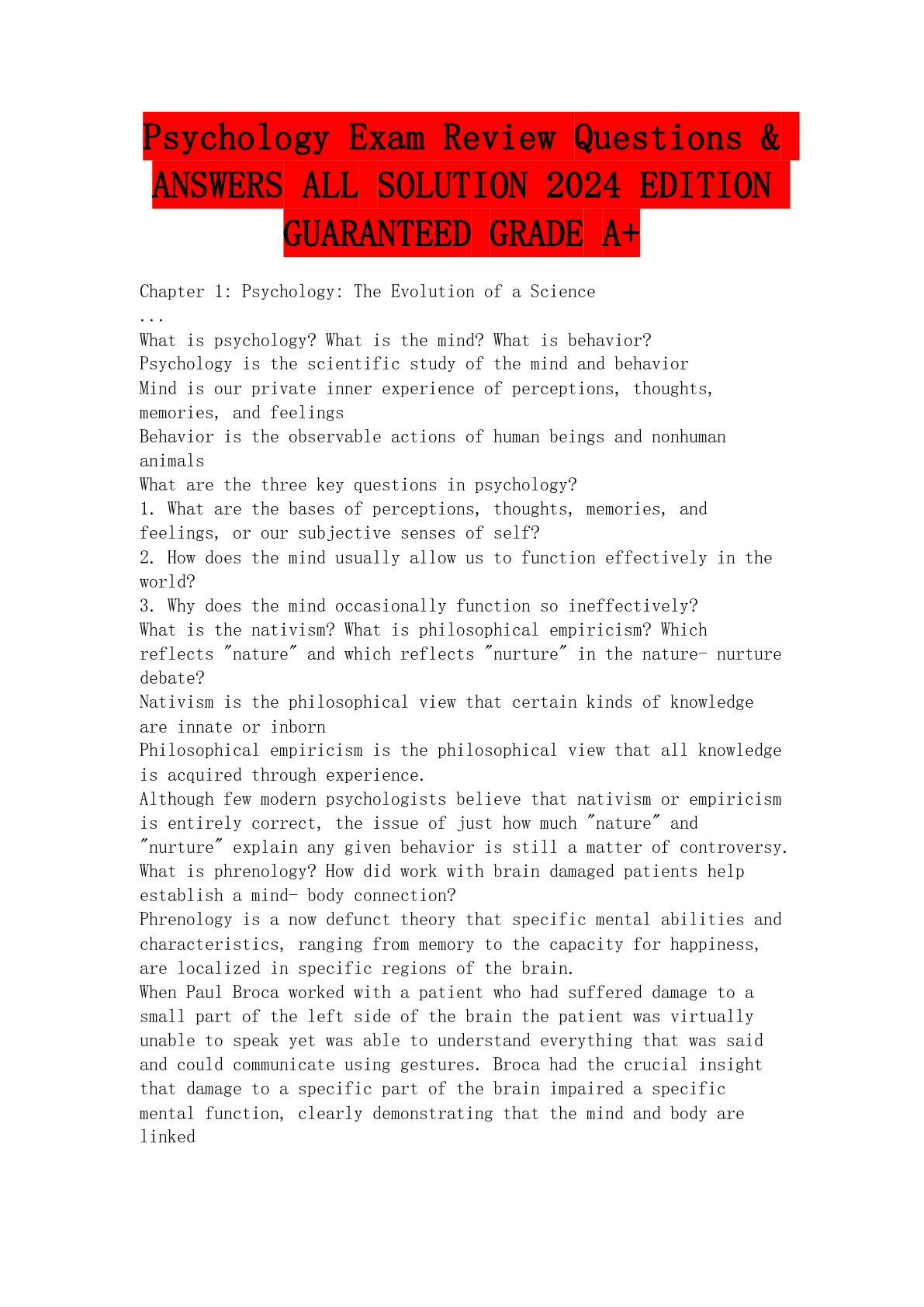
Reviews( 0 )
Document information
Connected school, study & course
About the document
Uploaded On
Jan 15, 2024
Number of pages
13
Written in
Additional information
This document has been written for:
Uploaded
Jan 15, 2024
Downloads
0
Views
22


